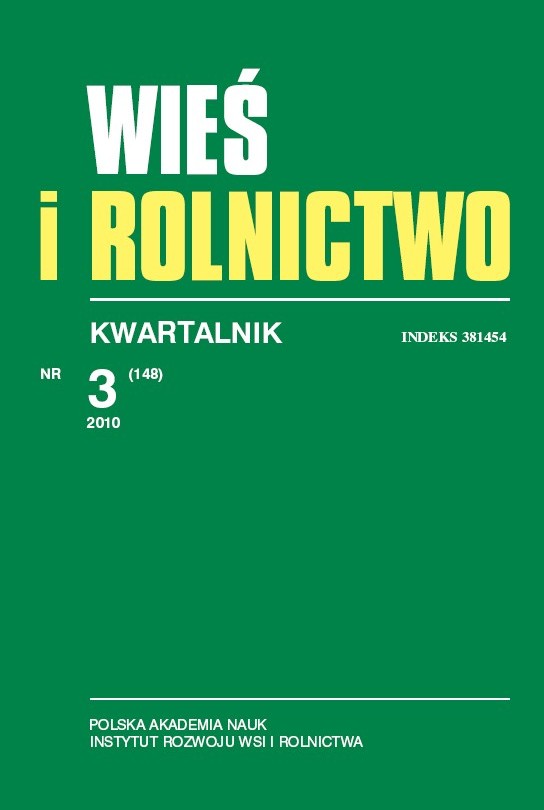The Impact of the Liquidation of Milk Quotas on the Economic Situation of Milk Producers in the European Union (Results of Model Simulations)
DOI:
https://doi.org/10.53098/wir.2010.3.148/09Keywords:
milk production in EU, milk quotas, forecast economic situation of milk producersAbstract
The aim of the conducted research was the simulation of the possible effects of the liquidation of milk quotas for the producers of milk in the European Union. The object of analysis was the comparison of simulated situation s on the milk market in 2020 in the case of continuation and liquidation of the system of quotas. For the purpose of research the CAPRI (Common Agricultural Policy Regionalised Impact) model was used. The analysis of the obtained simulation results showed that in the effect of the liquidation of the system of quotas the production of milk would be moved to the regions of Europe where the climatic conditions and relatively low costs are conducive to the development of production. Also, territorial reorganization of milk production would probably take place in many countries. Thus, the liquidation of milk quotas would facilitate the rationalisation of spatial distribution of milk production from the point of view of its effectiveness and would improve the European Union’s competitive position on the global market.
References
Adenauer M., 2008: CAPRI versus AGLINK-COSIMO. Two partial equilibrium models – Two baseline approaches. 12th Congress of the European Association of Agricultural Economists, Ghent.
Agricultural Outlook 2007–2016, 2007. OECD-FAO.
Analiza sytuacji na rynku unijnym mleka oraz możliwości liberalizacji tego rynku, 2007. FAPA, Warszawa.
Britz W., Witzke P., 2008: CAPRI model documentation 2008: Version 2. Institute for Ford Resource Economics. University of Bonn, Bonn.
Conforti P., 2001: The Common Agricultural Policy in main partial equilibrium models. Osservatororio sulle Politiche Agricole dell’UE, Working Paper 7, INEA.
Dairy Report, 2008: For a better understanding of milk production world wide. International Farm Comparison Network.
Economic analysis of the effects of the expiry of the milk quota system. Final report, 2008. Institut d’economie industrielle, Toulouse.
Garforth C., Rehman T., 2006: Review of Models for Agricultural Policy Analysis. The University of Reading, School of Agriculture, Policy and Development. Project Report 5, London.
Nawrot B., 2008: Analiza proponowanej reformy Wspólnej Polityki Rolnej (tzw. health check) z punktu widzenia interesów Wielkiej Brytanii. W: Reforma Wspólnej Polityki Rolnej z 2008 r. (health check) z punktu widzenia interesów wybranych państw członkowskich. UKIE, Warszawa.
Seremak-Bulge J., 2008: Wpływ kwotowania na funkcjonowanie rynku mleka. W: Rozwój sektora rolno-spożywczego w Polsce na tle tendencji światowych. Red. A. Kowalski, M. Wigier. IERiGŻ-PIB, Warszawa.
Seremak-Bulge J., Mańko S., 2008: Możliwości zmniejszenia negatywnego wpływu likwidacji kwot mlecznych na polskie gospodarstwa mleczne zlokalizowane w regionach zagrożonych spadkiem produkcji mleka. W: Reforma Wspólnej Polityki Rolnej w kontekście potrzeb i interesów polskiego rolnictwa. UKIE, Warszawa.
Sytuacja na rynku przetworów mlecznych w 2009, 2009. Komunikat Komisji do Rady, Bruksela.
Tongeren F., van Meijl H., van Surry Y., 2001: Global models applied to agricultural and trade policies: A review and assessment. ”Agricultural Economics” 26. DOI: https://doi.org/10.1111/j.1574-0862.2001.tb00060.x
Weissleder L., Adenauer M., Heckelei T., 2008: Impact assessment of trade liberalization between EU and Mercosur countries. 107 EAAE Seminar ”Modelling of Agricultural and Rural Development Policies” Sevilla, Spain.
Wojna B., 2008: Analiza proponowanej reformy Wspólnej Polityki Rolnej (tzw. health check) z punktu widzenia interesów Hiszpanii. W: Reforma Wspólnej Polityki Rolnej z 2008 r. (health check) z punktu widzenia interesów wybranych państw członkowskich. UKIE, Warszawa.
Downloads
Article file downloads
Pages
How to Cite
Issue
Section
License
Copyright (c) 2010 Wieś i Rolnictwo

This work is licensed under a Creative Commons Attribution 4.0 International License.










